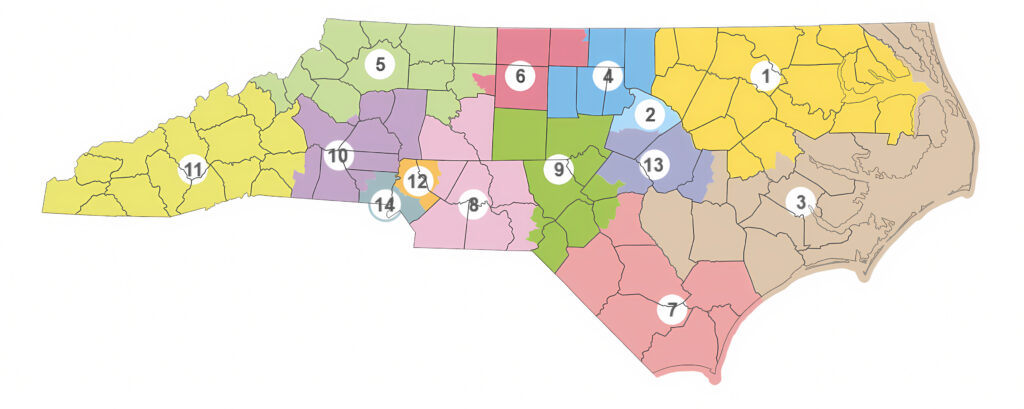By Penny Gordon-Larsen for Carolina Research
Every day Carolina researchers make discoveries with impact that save and transform lives far beyond the confines of our campus. Their work touches every one of North Carolina’s 100 counties and researchers from our health affairs schools work in communities across the state, offering programs to prevent, manage, and treat diseases of all kinds. In addition to enhancing wellness statewide, research provides an economic boost. In fact, last year our research employed more than 11,000 North Carolinians, generated $38 million in tax revenue, and brought in $1.21 billion in grants and awards.
This week, we refreshed our interactive state impact map with updated content, highlighting the diverse projects and initiatives that are driving innovation and improving lives in communities throughout the state. It also includes a county-by-county breakdown of undergraduate students participating in research opportunities that will prepare them to be the highly skilled workforce of our state’s future.
I invite you to dive into the map and uncover the real-world results of our innovative research, and continue reading to discover just a glimpse of the transformative work taking place across our state.

Engineering and Applied Sciences
I recently had the opportunity to tour the NC Pure facility in Research Triangle Park along with Chancellor Lee Roberts, and we were extremely impressed with the game-changing solutions being developed there. NC Pure is a research initiative spearheaded by the NC Collaboratory that is developing technologies for removing harmful per- and polyfluoroalkyl substances (PFAS) from water sources. The initiative is contributing to a deeper understanding of PFAS contamination, and the challenges associated with removing these harmful chemicals from water. By developing innovative solutions and fostering collaboration, NC Pure is helping to protect North Carolina’s water resources and ensure a healthier future for its citizens.
In the Gillings School of Global Public Health, environmental engineers are developing novel solutions to even more public health crises affecting our state. New research from Jason Surratt, in collaboration with Barbara Turpin, both of the Department of Environmental Sciences and Engineering (ESE), has developed a new method for measuring PFAS in real-time, directly from the air which can more effectively monitor and regulate PFAS pollution. This technology can significantly improve public health and environmental protection across our state, especially in areas with industrial sites like Fayetteville. In providing more accurate data on PFAS emissions, we can help inform environmental regulations.
Another recent tour took the Chancellor and I through the halls of the Mary Ellen Jones building to see some of the research projects of the UNC/NC State Joint Department of Biomedical Engineering that have significant statewide impact. The department has been at the forefront of developing new medical devices that improve patient outcomes like biomaterials that can be used to create implants that are more compatible with the body. They are also working to develop personalized approaches that tailor treatments to the individual needs of patients while addressing healthcare disparities and improving access to quality care for all. With strong external collaborations with industry and healthcare providers, they are ensuring that their research is translated into practical applications.
Energy, Water, Air and Environment
Carolina faculty are also leading the way when it comes to green, clean energy breakthroughs. Jingsong Huang, professor in the College of Arts and Sciences’ applied physical sciences department, recently won a 2025 Research Opportunities Initiative award funded by the North Carolina General Assembly. Huang is collaborating with NC State University to boost North Carolina’s energy production and reduce dependence on out-of-state fossil fuels. Their goal is to create all-perovskite tandem solar cells, which have potential to be twice as efficient as silicon-based solar cells.
A recent study led by Noah Kittner in ESE suggests that transforming retired coal power plants into renewable energy facilities could be a beneficial solution for both the environment and local economies. Researchers found that this approach can significantly reduce carbon emissions, lower energy costs, and create new economic opportunities. The study proposes retrofitting old coal plants with solar panels and batteries. This would not only be more cost-effective than building new renewable energy infrastructure but would also revitalize communities that have relied on coal-fired power.
Amanda DelVecchia’s lab in the Department of Geography & Environment studies greenhouse gas emissions from streams. The lab’s current study, called the MacroGas Project, questions how different stream characteristics affect how much greenhouse gas is produced or released into the atmosphere from watersheds. They have found that warmer, shallower streams, common in North Carolina’s Piedmont region, emit the most carbon dioxide. By focusing on areas with high emissions and refining their methods, they aim to better understand the state’s freshwater biogeochemistry.
Currituck County is losing nearly 72 acres of marsh annually due to erosion and rising sea levels. Traditional satellite imagery offers limited resolution for tracking marsh health, but researchers at the Carolina Drone Lab, a collaborative research unit within the UNC Institute for the Environment, are using aerial imagery to assess marsh conditions in the Outer Banks. By creating digital surface models, they can monitor marsh elevation and compare it to sea level rise. This data can help inform erosion mitigation and coastal restoration efforts.
Launched just last month, our new Institute for Risk Management and Insurance Innovation (IRMII), led by Greg Characklis, aims to address financial risks from threats like extreme weather and cybersecurity. IRMII will conduct research, train students, and collaborate with industry partners. The institute will provide interdisciplinary training for students and develop an undergraduate minor in risk management and is expected to make a significant impact across the state. It will generate innovative ideas, benefit the risk management and insurance industry, attract funding, and prepare students for the future workforce.
Wellbeing
The UNC Nutrition Research Institute (NRI) is a cornerstone of the North Carolina Research Campus in Kannapolis, a city that has experienced significant economic revitalization thanks to this cutting-edge research facility. The NRI is dedicated to understanding the complex interplay between genetics, nutrition, and health, with a particular focus on precision nutrition. The institute has made a significant impact on the local community by driving economic growth, improving healthcare services, and fostering a culture of innovation and research excellence. Its commitment to translating research into practical applications is helping to improve the health and well-being of people around the state and world.
Led by the UNC Highway Safety Research Center (HSRC), in collaboration with the Department of City and Regional Planning and the Injury Prevention Research Center (IPRC), the Collaborative Sciences Center for Road Safety(CSCRS) unites leading transportation research, planning, public health, data science, and engineering programs at institutions across the country. One CSCRS-funded project is addressing the sharp increase in pedestrian fatalities in the U.S in recent years. The study, led by HSRC co-Director Laura Sandt, is analyzing data and seeking to identify the root causes of these rising fatalities with the goal of developing innovative strategies that inform efforts to improve pedestrian safety state and nationwide.
The UNC School of Medicine recently partnered with Novant Health, UNC Health, and the Naval Medical Center Camp Lejeune to launch a psychiatric residency program that trains more physicians in southeastern North Carolina and boosts the pipeline of much-needed mental health physicians around the major military installation. The initial class of seven psychiatric residents began their four-year programs in June 2024 and are providing specialized care for individuals serving in the military, treating conditions such as post-traumatic stress disorder and traumatic brain injury.
The North Carolina Collaboratory recently awarded five grants — funded by a $1.9 million state appropriation to projects — across the UNC System aimed at bolstering community and local government efforts to combat the opioid crisis. The Monitoring the North Carolina Drug Supply for Timely Action project, led by IPRC’s Nabarun Dasgupta, seeks to enhance public health response to the opioid crisis. By leveraging an existing drug testing service, this project will provide health departments, harm reduction programs, and clinics with real-time data on illicit drug supplies through a statewide drug alert system developed in partnership with the UNC Hussman School of Journalism and Media.
We are grateful for strong partnerships with groups like NC Collaboratory and the North Carolina General Assembly who are supporting statewide research that has tangible benefit for our citizens. We, in turn, are also working on expanding resources to other N.C. research institutions. One goal of the Research Roadmap, our strategic plan for continued growth, is to establish sustainable funding models for research facilities and equipment. Carolina has over 140 core facilities that serve researchers both within and outside the University, and beginning in 2025, we will charge internal breakeven rates to all UNC System institutions. This change will promote collaboration, increase access to our facilities, and provide more affordable services to researchers across the state.
Carolina’s research is making a significant impact across North Carolina. Through innovative projects in fields like engineering, health affairs, energy, and social sciences, our researchers are addressing pressing challenges and improving lives in communities. From developing new technologies that combat PFAS pollution to enhancing mental health services, our work drives statewide solutions and brings a significant return on the state’s investment in our University.
The preceding article originally appeared on September 11, 2024 at UNC Research’s website and is made available here for educational purposes only. This constitutes a ‘fair use’ of any such copyrighted material as provided for in Title 17 U.S.C. section 106A-117 of the U.S. Copyright Law. Photo above: the Old Well at the University of North Carolina at Chapel Hill.



